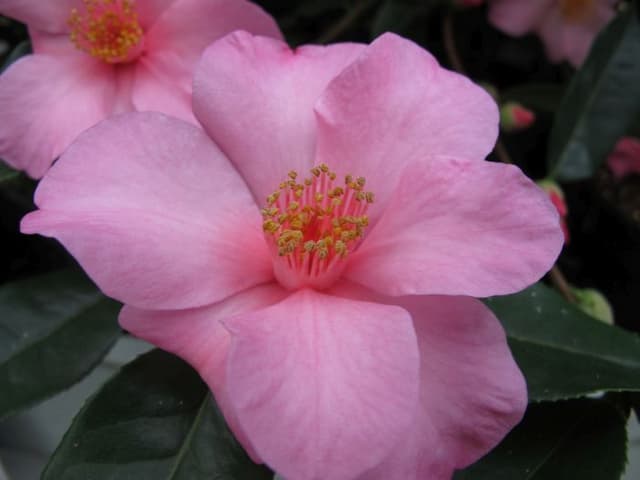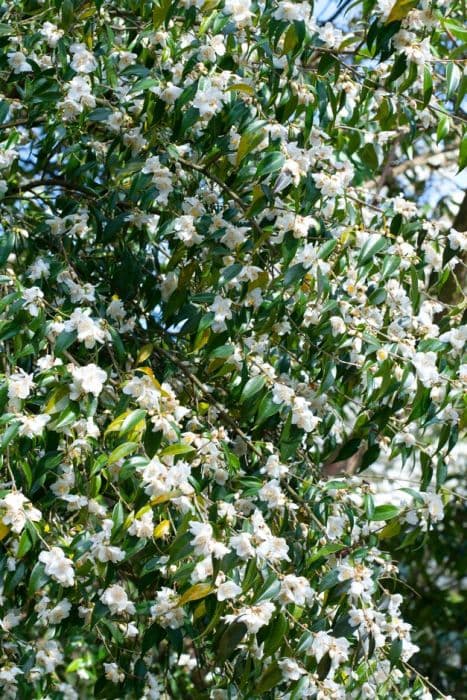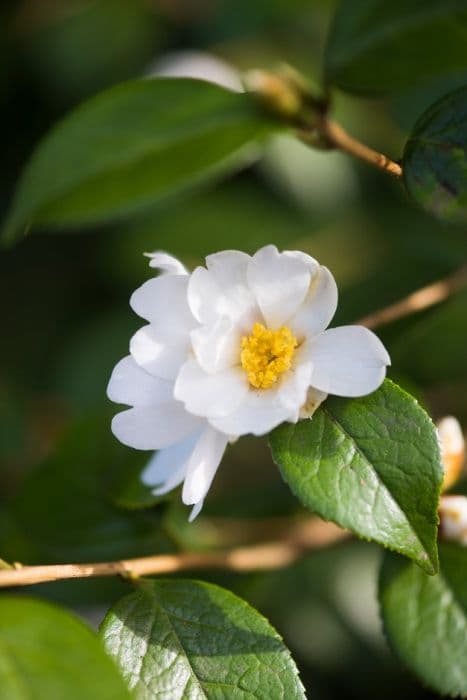Chinese Stewartia Stewartia sinensis

ABOUT
Stewartia sinensis, also commonly referred to as Chinese stewartia, is a deciduous shrub or small tree that is highly appreciated for its ornamental qualities. This plant is characterized by its dark green, oval to elliptical leaves which provide a lush, dense foliage during the growing seasons. The edges of the leaves are finely serrated, and they often turn to striking shades of red, orange, or burgundy before falling off in the autumn, adding a splash of color to gardens and landscapes. The bark of Chinese stewartia is another distinctive feature, exfoliating in patches to reveal a mosaic of gray, brown, and orange tones underneath, a trait that provides year-round interest even when the plant is without leaves. It's the flowers, however, that are the real showstoppers. They bloom in the summer and are cup-shaped with beautiful, delicate white petals, each flower possessing a gentle, captivating symmetry. At the center of each flower is a cluster of bright yellow stamens, which contrast strikingly with the white petals. These blooms not only add visual appeal, but also attract pollinators such as bees and butterflies to the garden. After flowering, fruits develop which are dry, woody capsules that add yet another layer of interest to the plant as they persist into the winter. Overall, the appearance of the Chinese stewartia is one of refined beauty, making it a prized specimen for gardens where visual interest throughout the seasons is desired. Its striking blooms, colorful foliage in the fall, and attractive peeling bark ensure that this plant continues to enchant onlookers throughout the year.
About this plant
 Names
NamesFamily
Theaceae
Synonyms
Chinese Stewartia, Deciduous Camellia
Common names
Hartia sinensis.
 Toxicity
ToxicityTo humans
Chinese Stewartia is generally considered non-toxic to humans. There are no major reports or studies indicating that this plant possesses poisonous qualities for people, and ingestion of this plant is not commonly known to result in any adverse effects. However, as with any plant material, individual allergies or sensitivities could potentially cause mild discomfort if ingested or handled, such as stomach upset or skin irritation. It is always advisable to exercise caution and prevent the ingestion of plant parts if the toxicity status is uncertain.
To pets
Chinese Stewartia is also generally considered non-toxic to pets. There is no significant evidence or reports to suggest that this plant poses a poisoning risk to household pets such as dogs and cats. Pets that consume parts of this plant are unlikely to experience severe symptoms of poisoning. However, as with humans, individual animals might have sensitivities that could result in mild gastrointestinal upset. Owners should discourage pets from eating ornamental plants as a precaution and monitor them for any signs of distress when introducing new plants to the environment where pets have access.
 Characteristics
CharacteristicsLife cycle
Perennials
Foliage type
Deciduous
Color of leaves
Green
Flower color
White
Height
15-25 feet (4.5-7.6 meters)
Spread
10-15 feet (3-4.6 meters)
Plant type
Tree
Hardiness zones
6
Native area
China
Benefits
 General Benefits
General Benefits- Ornamental Value: Stewartia sinensis, commonly known as Chinese Stewartia, has beautiful, camellia-like white flowers with orange-yellow centers that add aesthetic appeal to gardens.
- Seasonal Interest: It features eye-catching, reddish-brown exfoliating bark that provides year-round visual interest, particularly in winter when the foliage is absent.
- Shade Tolerance: Chinese Stewartia can grow well in partly shaded conditions, making it suitable for understory planting or areas with dappled sunlight.
- Autumn Foliage: The leaves turn a range of colors in the fall, from red to purple or yellow, providing a striking autumnal display.
- Wildlife Support: The flowers of the Chinese Stewartia are attractive to pollinators, while the dense canopy can provide shelter for birds.
- Low Maintenance: Once established, Chinese Stewartia is relatively low maintenance, requiring minimal care beyond the occasional watering and mulching.
- Size and Form: With its pyramidal to oval form, it can be used as a specimen tree in residential gardens or public spaces without taking up too much space.
- Cold Hardiness: Chinese Stewartia is cold hardy in a variety of temperate climates, meaning it can survive and thrive in many northern regions.
 Medical Properties
Medical PropertiesThis plant is not used for medical purposes.
 Air-purifying Qualities
Air-purifying QualitiesThis plant is not specifically known for air purifying qualities.
 Other Uses
Other Uses- Artistic inspiration: The striking flowers and bark of the Chinese Stewartia serve as a source of inspiration for artists and photographers, particularly in botanical illustrations and nature-focused art pieces.
- Bonsai: Due to its attractive form, foliage, and bark, Chinese Stewartia is sometimes cultivated as a bonsai specimen, requiring careful pruning and shaping.
- Educational tool: In botanical gardens and arboreta, Chinese Stewartia is utilized to educate visitors about plant diversity, especially in temperate woodland garden settings.
- Woodcraft: The wood of Chinese Stewartia is occasionally used in fine woodworking or turnery for making small decorative objects due to its hardness and texture.
- Dye production: Certain parts of the plant might be used to extract natural dyes for textile coloring, although this is not a common practice.
- Environmental education: Due to its unique characteristics and native habitat, it can be featured in environmental programs to demonstrate the importance of plant conservation.
- Seasonal decoration: In autumn, the leaves of Chinese Stewartia turn colorful shades, which can be used in seasonal floral arrangements and decorations.
- Wildlife garden: The plant can contribute to a wildlife-friendly garden by providing habitat and seasonal food for native insects and birds.
- Photographic subject: The intricate details of the Chinese Stewartia flowers and leaves are often sought after by photographers for macro photography.
- Plant studies: Chinese Stewartia can be used in dendrological studies to compare the adaptations and growth habits of trees in different habitats.
Interesting Facts
 Feng Shui
Feng ShuiStewartia sinensis is not used in Feng Shui practice.
 Zodiac Sign Compitability
Zodiac Sign CompitabilityStewartia sinensis is not used in astrology practice.
 Plant Symbolism
Plant Symbolism- Beauty: Stewartia sinensis, commonly known as Chinese Stewartia or Deciduous Camellia, possesses a graceful beauty with its camellia-like flowers and peeling bark, symbolizing both visual appeal and inner charm.
- Resilience: This plant is able to adapt to various climates and soil conditions, representing the ability to withstand adversity and change.
- Rarity: As a less commonly found garden plant, the Chinese Stewartia symbolizes uniqueness and the value of rare entities in nature.
- Harmony with Nature: Its tendency to blend into woodland settings symbolizes a seamless connection with the natural world and the importance of ecological balance.
- Seasonal Change: With its distinctive seasonal changes, from spring flowers to autumn foliage and interesting winter bark, the Chinese Stewartia symbolizes the passage of time and life's constant evolution.
 Water
WaterChinese Stewartia appreciates even moisture, so it's important to water it regularly. During the growing season, typically spring through fall, water the plant once or twice a week, delivering about 1 inch of water each time. You can measure this by using a rain gauge and ensuring it reaches an inch or by applying approximately half a gallon of water for smaller plants and up to 2 gallons for larger, established trees. During winter, reduce watering, allowing the soil to partly dry out between waterings as growth slows down. Adjust watering frequency based on weather conditions, more during hot, dry spells, and less during rainy periods or cooler weather.
 Light
LightChinese Stewartia should be planted in a location where it can receive partial to full sunlight. It thrives best in spots with morning sun and light afternoon shade, especially in areas with hot summers. An ideal spot would be one that captures the gentle morning rays while shielding it from the harsh afternoon sun to avoid leaf scorch.
 Temperature
TemperatureChinese Stewartia grows well in environments where the temperature ranges between 60°F and 80°F. It is a hardy plant that can withstand a minimum of 20°F and a maximum of 90°F. For optimal growth and to ensure good health, maintain the temperature within this range, particularly avoiding exposure to extremes for prolonged periods.
 Pruning
PruningPrune Chinese Stewartia to maintain its shape and eliminate any dead or broken branches. The best time to prune is in the late winter or early spring, just before new growth begins, allowing the plant to heal quickly and grow vigorously. Pruning should be done conservatively, and only once a year, as over-pruning can stress the tree.
 Cleaning
CleaningAs needed
 Soil
SoilChinese Stewartia thrives in acidic, well-draining soil with a pH of 5.5 to 6.5. A mixture of peat, pine bark, and perlite or coarse sand is ideal, providing both drainage and moisture retention.
 Repotting
RepottingChinese Stewartia trees do not need frequent repotting; every 2-3 years is sufficient. Young trees may be repotted more often to encourage growth, while mature trees can go longer.
 Humidity & Misting
Humidity & MistingChinese Stewartia prefers moderate to high humidity levels, ideally around 50-60% humidity, to mimic its natural woodland habitat.
 Suitable locations
Suitable locationsIndoor
Provide bright indirect light, avoid dry air and keep soil moist.
Outdoor
Plant in part shade, shelter from wind, mulch root zone well.
Hardiness zone
6-8 USDA
 Life cycle
Life cycleStewartia sinensis, commonly known as Chinese stewartia, begins its life as a seed that germinates in moist, well-drained soil in late winter or early spring. The seedling emerges and develops into a juvenile plant, featuring a low branching structure and foliage characteristic of young specimens. As it matures, the Chinese stewartia undergoes vegetative growth, forming a small to medium-sized deciduous tree with a pyramidal to oval shape and distinctive smooth, exfoliating bark. In early to mid-summer, the adult Chinese stewartia reaches its reproductive stage, producing showy, camellia-like flowers with white petals and orange centers which are pollinated by insects. Following pollination, the tree produces seed capsules that mature in late summer or fall, eventually releasing seeds to complete the cycle. Throughout its life, which can span several decades, the Chinese stewartia undergoes seasonal changes, losing its leaves in the fall and entering a dormancy period during the winter months.
 Propogation
PropogationPropogation time
Spring-Early Summer
The Chinese Stewartia, scientifically known as Stewartia sinensis, is commonly propagated through seeds. The best time for sowing Stewartia seeds is in the fall when the seeds are fresh. They need a period of cold stratification, which is a process of subjecting the seeds to cold temperatures to break their dormancy. This can be done naturally by sowing the seeds outdoors in autumn to allow them to overwinter, or by artificially stratifying the seeds in a refrigerator, typically at temperatures around 33-41°F (0.5-5°C), for a period of two to three months. After stratification, the seeds can be sown in a well-draining soil mix and should germinate in the spring as temperatures rise. While seed propagation is the most popular method, patience is required as the Chinese Stewartia can take several years to flower when grown from seed.









